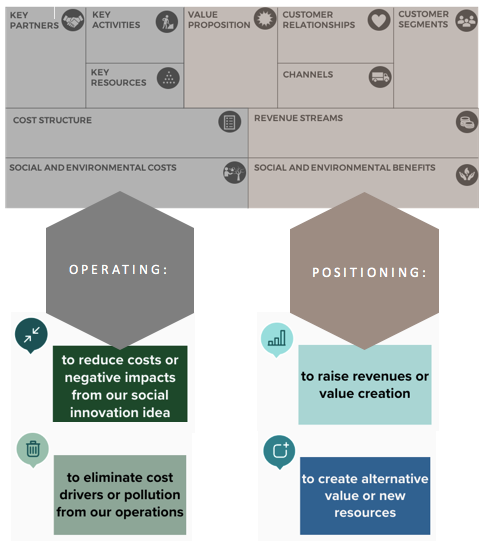Executive Summary
In order for a business to survive in a competitive market it needs to have competitive advantage that sets it apart from the other businesses which are essentially targeting the same customers. Innovating business models can be essential for achieving competitive advantage and making the business more viable. This factsheet offers a step-by-step guide on how to find an innovation strategy that is specific to your business and that will increase your competitive advantage.
Innovation and Competitive Advantage
Innovation in the context of WASH businesses is not as simple as doing something in a creative way. A WASH business innovation is only an innovation if it works in the market, or in other words, if it increases the competitive advantage of your business, your impact or your viability. Against this backdrop, the overall goal of an innovation strategy should be to create a competitive advantage.
What does having a competitive advantage actually mean though? In order to enter the market with a new product or service and ensure that your business survives in it in the long-run, you need to perform better, cheaper or faster than your competitors or competing solutions. Put simply, you need to have an advantage over them! For example, the start-up DiPure from India, developed tea-bag-shaped water filters from Moringa seeds that are not only cheaper and more eco-friendly than conventional water filters but the water also tastes better than that of chlorine-based water purifiers. Another good example is the start-up Joona from Lebanon, which has set out to end “period poverty”. By selling luxury cosmetics to high-end customers, they are able to provide women in need with ‘dignity kits’: packages which consist of 3-months’ supply of menstrual hygiene products. In this way, they not only manage to cover their costs and reach viability, but they also have a considerable positive social impact while addressing a stigmatised topic in an innovative and effective way.
How to Define your Innovation Objective
Whether your innovation objective should be to become better, faster or cheaper depends largely on the innovation challenge you have defined. Before you can engage in the ideation process – that is, coming up with ideas on how to innovate your business model – you need to analyse your internal and external business environment, either by analysing your business idea or by conducting a SWOT-analysis of your business model and defining your innovation challenge. Your innovation challenge will read something like this:
- “How might we keep our logistical costs down by engaging waste pickers in the collection process?”
- “How might we create new revenue streams from rural subsistence farmers by speeding up their experience of sourcing water and thus create willingness to pay?”.
These innovation challenges describe what you want to achieve (objective), the subject to be influenced or affected and how you intend to innovate your business model to achieve this objective. These innovation objectives can be divided into four categories and they are linked to either the operational side or the positioning side of your business model (see graphic below).
- reduce costs or negative social and environmental impacts
- eliminate cost drivers, dependencies and negative impacts
- raise positive social and environmental impact and revenues
- create new or additional revenues or positive impacts.
Prioritising innovation objectives is no easy task, but by doing a SWOT analysis of your business model and formulating priority innovation challenges, you should have narrowed down the focus of your innovation process already. If you haven’t already done so, do the analysis now.

Exploring Innovation Strategies
Once you have defined your innovation objective, you need to develop an appropriate strategy for achieving it. In the following four sections, we have documented various examples of innovation strategies in start-ups primarily from the Middle East (but also from other countries) that are linked to the innovation objectives described above, therefore allowing the business to increase revenues, impacts or value or to decrease costs or negative impacts.
Decreasing or eliminating costs or negative impacts is inherently linked to the operating side of your business model since it calls for innovating your activities, resources, partnerships or cost structure (see graphic above). Raising or creating revenues, positive impacts or value is linked to the positioning side of your business model because it calls for innovating your value proposition, customer segments, customer relationships, channels or revenue streams. For example...
- ...reducing costs or negative impacts can be done by using remote sensing to get more reliable data for more efficient operations and maintenance. GARV Toilets, a start-up from India, provides public toilets that are integrated with smart tech features which allow the implementing company to get real-time updates of service usage and functionality, which in turn minimises the resources spent on O&M activities. More strategies for reducing negative impacts or costs can be found here.
- ...eliminating cost or negative impacts can be done by using eco-friendly materials and technology. The Jordan company WashyWash has made the switch from an outdated and risky PERC-Dryclean system to eco-friendly cleaning technologies. It offers two eco-friendly cleaning technologies: Eco wet-clean and Eco dry-clean to get rid of toxic chemicals in laundry and dry cleaning. On top of this, the company uses its own environmentally friendly bags while offering easy pick-up and delivery via an App. More strategies for eliminating negative impacts or costs can be found here.
- ...raising revenues or impacts can be done by selling convenience rather than basic services to raise willingness to pay. BENAA Foundation, a youth-led organisation from Egypt, constructs Water Kiosks and installs treatment units for selling drinking water to off-grid customers. Realising that merely setting up functioning water kiosks will not ensure the willingness of the community to pay for water, they adapted the basic water kiosk business model and repositioned the offer by adding a door-step delivery service. This complementary service relieves customers from the burden of carrying water home from a water point, thus increasing convenience for them and raising their willingness to pay for the service (and water). More strategies for raising positive impacts and revenues can be found here.
- ...creating new revenue streams or impacts can be done by giving customer segments with low purchasing power who can’t afford your products, access to microcredits that will allow them to afford your product. The start-up CASSA from Guatemala sells eco-housing to customers at the Base of the Pyramid through partnerships with microcredit institutes. As energy and resource independent houses, the house owners can save on utility costs which will allow them to repay their microcredit loans. More strategies for creating new or additional revenues or positive impacts can be found here.
If you cannot find a fitting strategy for innovating your business model, you might want to go through some ideation exercises to help you assess your innovation challenge(s) from a different angle and hopefully come up with new ways of solving them.
Define your Innovation Strategy
Once you have browsed through the various strategies for innovating your business model and decided what the strategy for your business will be, it is time to formulate it. Use this worksheet to do so.
- Repeat your innovation challenge in the How-Might-We format. Remember your innovation challenge describes what you want to achieve (objective), the subject to be influenced or affected and how you intend to innovate your business model to achieve this objective.
Example: How might we create new revenue streams from rural subsistence farmers by speeding up their experience of sourcing water and thus creating willingness to pay?
- Repeat your innovation objective. Is your objective to:
- reduce costs or negative social and environmental impacts?
- eliminate cost drivers, dependencies and negative impacts?
- raise positive social and environmental impact and revenues?
- create new or additional revenues or positive impacts?
Example: Our objective is to create new revenue streams by increasing their willingness to pay.
- Once you’ve done this, formulate your innovation strategy in the following format: what you want to achieve – the subject to be influenced or affected – how you specifically intend to innovate your business model – and the benefits of this innovation for your customers or your business.
Example: We will create new revenues streams from farmers by offering on-farm-delivery of nutrient-enriched irrigation water and thus increase their farming efficiency and crop yields.
- Make sure that your innovation strategy not only addresses the defined innovation challenge, but that it also takes the SWOT analysis of your business model into account. There is no point installing smart sanitation systems to make O&M more efficient when internet connectivity and power cuts are a problem in your area (this would have been identified as a threat in the SWOT analysis). If the chosen innovation strategy will substantially change your business model (for example WASH business venturing into solid waste recycling), you might also have to conduct another SWOT analysis that covers “new” strengths, weaknesses, opportunities and threats that weren’t relevant under the old business model (i.e. there is no point in venturing into the production of high-value products from plastic waste from landfills when the municipality is planning to burn all waste in incinerators in the future (threat)).
- Your innovation strategy looks great now...on paper. But will it really allow you to reach your objectives and obtain a competitive advantage? You can only find out if you test it under concrete market conditions. Before you carry on with the rolling out of your innovation strategy company-wide, validate it on a small scale. Check here to see how to go about validating your innovation strategy.

